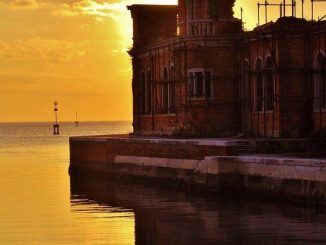
Articles by admin


The control over space, and the spaces of control: XIII Conference of Geocrìtica
From may 5th to 10th, 2014, the International conference “El control del espacio y los espacios de control”, will be held in the University of Barcelona, organized by the review Geocrítica; with the linked reviews ScriptaNova and Biblio3w, this is one of the most important and interesting publication on urban issues in the whole spanish-speaking area. The conference is public and admission free of charge; we suggest these sessions, in which some members of our OACU group will be involved: may 6th, Ocupación del espacio y control de los individuos at 9am, Segregación social y urbana a at 6.30pm; may 9th, Organización económica, poder y control at 9am, Cambios en las formas de control at 4pm.
- Here is the programme of the conference, with the list of papers and tables; for more information, visit the webpage.
- Here are the Papers of the conference, and the num. 493 of Scripta Nova with all the selected interventions!
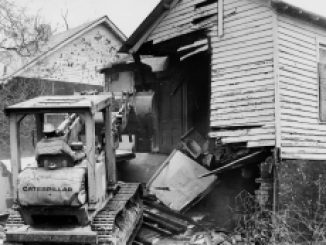
Root shock: how the destruction of black communities hurt the US

The ghosts of San Berillo
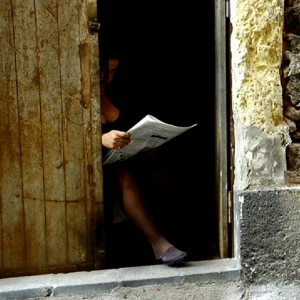 Different cities follow one another on the same site and under the same name, writes Italo Calvino, born and dying without knowing one another, without communication among themselves. At time even the names of the inhabitants remain the same, and their voices’ accent, and also the features of the faces; but the gods who live beneath names and above places have gone off without a word and outsiders have settled in their place. It is pointless to ask whether the new gods are better or worse than the old, since there is no connection between them… We recommend you another Italian documentary movie: Edoardo Morabito and Irma Vecchio’s I fantasmi di San Berillo (2013), first prize at Torino Film Festival. The demolition of this old neighbourhood in the centre of Catania (Sicily), in 1958, was the biggest urban evisceration in post-war Italy, linked (as everything in the country) with Vatican’s Società Generale Immobiliare: 30.000 people where displaced towards the peripheries. It was the same year in which brothels were banned: prostitutes were forced to work underground, and what was left of San Berillo turned into one of the biggest “red light districts” of the Mediterranean. So the story of the neighbourhood went on for another half century, until 2001, when a new police operation evicted again prostitutes and transvestites from their houses and streets. Today many plots are still unoccupied, and some became new favelas (see this 2012 video). The documentary shifts visually from past to present, and the images are associated with the fascinating words of writer Goliarda Sapienza, born in San Berillo in 1924.
Different cities follow one another on the same site and under the same name, writes Italo Calvino, born and dying without knowing one another, without communication among themselves. At time even the names of the inhabitants remain the same, and their voices’ accent, and also the features of the faces; but the gods who live beneath names and above places have gone off without a word and outsiders have settled in their place. It is pointless to ask whether the new gods are better or worse than the old, since there is no connection between them… We recommend you another Italian documentary movie: Edoardo Morabito and Irma Vecchio’s I fantasmi di San Berillo (2013), first prize at Torino Film Festival. The demolition of this old neighbourhood in the centre of Catania (Sicily), in 1958, was the biggest urban evisceration in post-war Italy, linked (as everything in the country) with Vatican’s Società Generale Immobiliare: 30.000 people where displaced towards the peripheries. It was the same year in which brothels were banned: prostitutes were forced to work underground, and what was left of San Berillo turned into one of the biggest “red light districts” of the Mediterranean. So the story of the neighbourhood went on for another half century, until 2001, when a new police operation evicted again prostitutes and transvestites from their houses and streets. Today many plots are still unoccupied, and some became new favelas (see this 2012 video). The documentary shifts visually from past to present, and the images are associated with the fascinating words of writer Goliarda Sapienza, born in San Berillo in 1924.

The Secret
In the middle of January, many neighbourhoods of Naples still celebrate the ritual of the cippo di Sant’Antonio. After New Year’s Day the young boys search the whole city for firewood, also very far from their neighbourhoods. Every gang gathers its woods in a secret place – “il segreto” – to protect them from the raids of the other gangs; they wait for the day of the bonfire, among the frenzy of the search for wood, and the clashes among the gangs, sometimes real, sometimes imaginary, to defend the treasure from the attacks of the “enemies”. Everything happens in the streets, almost twenyfour hours a day: at morning they often skip school, by night they guard the hiding place. To accomplish their aim, the gangs pass over all the obstacles, either if it is their neighbours complaining for the yellings, or the police threatening them to confiscate the firewood. At a closer look, though, an internal set of rules can be found: codes and habits that are preserved from one generation to another. They are the same children that in school appear empty, lazy, apathetic, or the opposite, uncontrollable and agitated. During the days of the “cippo” you see them passionate, interested and disciplined. In the adventurous game they built with their own hands, they appear transformed, until the final catharsis arrives: when the fire is lit, they dance around it, singing, and throwing in the flames the firecrackers and their own clothes.
- IL SEGRETO (2013), a film by cyop&kaf about the ritual of the “cippo” in Naples’ Quartieri Spagnoli neighbourhood; special mention of the Jury at the Torino Film Festival, selected by Paris international festival Cinema du Réel [trailer][webpage][review in Quinlan]
- “La sfida del cippo e la città alla finestra“, by Luca Rossomando, Repubblica Napoli 1/15/2013 [here also translated into spanish], and “Il segreto di Sant’Antonio“, Napoli Monitor n. 53, march 2013.
- cyop&kaf generally paints, even if at times it stumbles on writing, urbanism, photography. When it took a videocamera for the first time, it had already spent three years before in a dialogue with Naples’ Quartieri Spagnoli. The first fruit of that long work was a book, QS, then a movie, Il segreto: two pieces-synthesis, that together try to account the complexity of a neighbourhood corroded by prejudice. To look behind and inside the appearance, often brutal, of things. See also the video Quore Spinato [trailer] and the reportage Fuoco e fiamme [link]
- Napoli Monitor, review of reportages, drawings, researches and chroniques, explaining Naples and other cities since 2007 [webpage]
A mediados de enero, en muchos barrios de Nápoles se celebra aún <strong>el ritual del <em>Cippo di Sant’Antonio</em></strong>. Después de las fiestas de año nuevo, los chavales empiezan a buscar leña para quemar, incluso muy lejos de sus barrios. Cada pandilla acumula su leña en un escondite – <em><strong><a href=”http://www.cyopekaf.org/il-segreto/#1″ target=”_blank”>il segreto</a></strong></em> – para protegerla de los asaltos de las pandillas de otros barrios. La espera del día de la hoguera, el 17 de enero, se consuma en búsquedas frenéticas y en las peleas, a veces reales, otras veces imaginarias, para defender el tesoro de los “enemigos”. <strong>Todo acontece en la calle, casi venticuatro horas al día</strong>; por la mañana se salta la escuela, por la noche se hacen turnos para vigilar el escondite. Para llegar al objetivo, las bandas están dispuestas a pasar por encima de todo, sean los vecinos del barrio que se quejan del ruido, sea la policía que amenaza con secuestrarlo todo. Observando más de cerca, pero, se descubren reglas y códigos de comportamiento que se transmiten de una generación a la otra:<strong> son los mismos niños que en el colegio aparecen vacíos, perezosos, desmotivados, incontenibles e irrequietos; en los días del <em>cippo</em> en cambio se los ve apasionados, atentos y disciplinados</strong>. En el juego aventuroso que han construido con sus manos aparecen transformados, hasta la catársis final, cuando se enciende el fuego y se baila, cantando y tirando en las llamas los petardos y la ropa.
<ul>
<li><strong>IL SEGRETO</strong> (2014), una película de <strong>cyop&kaf</strong> sobre el ritual del <em>Cippo </em>en el barrio <em>Quartieri Spagnoli</em> de Nápoles; de una idea de <strong>Luca Rossomando</strong>. Mención especial del jurado en el <a href=”http://www.torinofilmfest.org/?action=article&id=427″ target=”_blank”>Torino Film Festival</a>, seleccionado para el festival internacional <em>Cinema du Réel</em>, Paris <strong>[<a href=”http://www.youtube.com/watch?v=s0pPPZpHEV0″ target=”_blank”>trailer</a>][<a href=” http://www.cyopekaf.org/il-segreto/#1″ target=”_blank”>página web</a>][<a href=”http://quinlan.it/2013/11/24/il-segreto/” target=”_blank”>reseña en <em>Quinlan</em></a>]</strong></li>
<li>”<a href=”http://napolimonitor.it/2014/01/16/24309/la-sfida-del-cippo-e-la-citta-alla-finestra.html” target=”_blank”>La sfida del cippo e la città alla finestra</a>”, de <strong>Luca Rossomando</strong>, <em>Repubblica Napoli </em>15/1/2013, y “<a href=”http://napolimonitor.it/2014/02/07/24493/il-segreto-di-cyopkaf-la-prima-napoletana.html” target=”_blank”>Il segreto di Sant’Antonio</a>”, <em>Napoli Monitor</em> n. 53, marzo 2013. <strong>
</strong></li>
<li><strong>cyop&kaf </strong>dibuja, aunque a veces tropieza en la escritura, en la urbanística, en la fotografía. Cuando ha cogido la cámara de video por primera vez, llevaba tres años dialogando con el barrio <em>Quartieri Spagnoli</em> de Nápoles. El fruto ha sido primero un libro, <a href=”http://www.cyopekaf.org/books/qs-un-libro-dai-quartieri-spagnoli” target=”_blank”>QS</a>, y ahora una película, dos obras-síntesis que juntas intentan dar cuenta de la complejidad de un barrio corroído por prejuicios. Para mirar detrás y dentro la aparencia a menudo brutal de las cosas. <strong>Ver también el vídeo <em>Quore Spinato</em> [<a href=”http://vimeo.com/84214894″ target=”_blank”>trailer</a>] y el fotoreportaje </strong><strong><em>Fuoco e fiamme</em> [<a href=”http://napolimonitor.it/fotoreportage/quartieri-spagnoli-fuoco-e-fiamme” target=”_blank”>link</a>]</strong><strong> </strong></li>
<li><strong>Napoli Monitor</strong>, revista de reportajes, investigación, dibujos y crónicas, activa desde 2007 [<a href=”http://napolimonitor.it/” target=”_blank”>página web</a>]</li>
</ul>

The Watchmen of Urban Conflict: OACU’s new webpage
This is the new toy that the Idle Magi brought yesterday, and that will cause sleepless nights for all the planners of gentrification and social peace: the new webpage of the Observatorio de Antropología del Conflicto Urbano (OACU)! You will find it in http://observatoriconflicteurba.org, it has a great media section, and you can try it now, by downloading the program of the I Ciclo “The social impact of architecture” that begins todaty january 8th, within the Master in Anthropology and Ethnography of University of Barcelona. Here you have more info, here the entire program. Thanks to the Magi and Long Live the Republic!…

Unlearning the colonial roots of planning
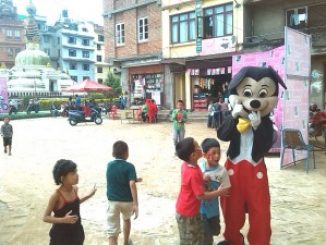
Where there be dragons: Multiple modernities in Kathmandu
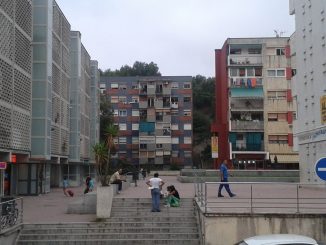
Ciudad Meridiana… exists!
The history of the neighbourhood of Ciudad Meridiana is a perfect summary of Barcelona’s urbanistic schizofrenia. Built in the Sixties on a land accounted as too damp to build a cemetery, with no transportation or services, secluded and unfit to live in, but with a strong neighbours’ movement, it has always been a problematic territory, unknown to the rest of the population: many of its inhabitants started to leave it already in the Eighties, trying to climb socially and spacially, getting over the decade in which the neighbourhood population reached its peak. Since 2001, when Catalonia and Spain were still inside the “housing market bubble”, the immigrants began arriving to Ciudad Meridiana, through mortgages the banks offered crossing the endorsements, and through other tricks that the financial capital used to “infiltrate the world of the urban poor”, as anthropologist Jaime PALOMERA writes in his essay about the neighbourhood. After the crisis began, Ciudad Meridiana was described as an eviction city, and now again for its strong neighbours and squatters movement. Recently there was an interesting debate: the City Council proposed to establish there an innovative “FabLab” related with MIT, but the neighbours reclaim that same spot for a food bank, much more useful to face the growing poverty of many families [see article here].
- Jaime PALOMERA (2013) “How did finance capital infiltrate the world of the urban poor: home ownership and social fragmentation”, International Journal of Urban and Regional Research [download pdf – article on Wiley]
- Photoreportage in Diagonal: “Infiernos y solidaridades en Ciudad Meridiana“
- Ciudad Meridiana PHOTO ALBUM by José Mansilla, 2013 (and one 1966 photo).
- Some more references: La Directa “Resistance in Eviction City” :: Lavanguardia.com “To invent or to eat?” :: elperiodico.com “Rice, oil and milk… or research and development?” :: Elpais.com “Ciudad desahucio” (eviction city), 20minutos “Villa desahucio” , Abc.com “Three evicted families establish in the squatted building”
- Links: Associació de Veins de Ciutat Meridiana :: Associació 500×20 Prou Especulacio :: Some questions to Associació 500×20 [in PDF]
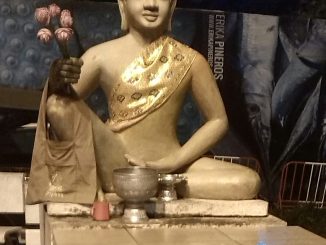
The protector of Phnom Penh

Conference in Bolonia: the subjective dimensions of vulnerability
On october 5th, in Bolonia (Italy) the Network for the Evaluation of the Subjective Dimensions of Vulnerability (REDISUV) Chile-Europe will meet for the second time, after the foundational Conference in Paris. The repeated natural catastrophes in Chile made evident the need for a more systematic study about the subjectivities of the communities affected, which are always the product of particular social, economical and political conditions. The program of the conference includes papers concerning natural desasters, but also approaches to the “urban” vulnerability, caused by neoliberal policies as the one our group has been studying in Barcelona.
- Bolonia, Thursday september 5th, 10am-6pm: “Vite invisibili: dimensioni soggettive della vulnerabilità sociale“, program in PDF.
- Davide Olori (2013) “Taking over the center to oppose evictions: the case of the Inmuebles Recuperados Autogestionados en Santiago de Chile” [PDF, italian]. “The urgency for housing after the earthquake forced towards the aggregation of both informal organizations (as neighbours, relatives, co-workers) and formal ones (political, parties…), so causing dynamics of rupture and recomposition among interests, hierarchies, relationships…”
- Fabio Carnelli studied ethnographically the consequences of the earthquake in L’Aquila (central Italy) some years after: the “militarized” solution brought again to life the traumas, and increased the vulnerability of the population. See Sismografie on Il lavoro culturale webpage. And also Rita Ciccaglione’s article, one year after the earthquake in Emilia Romagna.
- Caterina Borelli jsut published on academia.edu her PhD thesis about Sarajevo: “La ciudad post-traumática” (see also this older post)
- Stefano Portelli (2013) “Spatial reordering and social pathology in the periphery of Barcelona: the social impact of urban transformation”, intervención al XXI congreso del International Social Theory Consortium, Copenhagen, June 26-27th [Coming soon!]
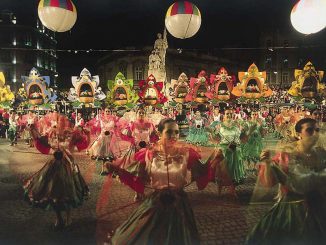
Two cities in the same Lisbon

Memories of the resistance: the Flor de Maig
The story of the city of Barcelona can be told focusing on its modifications: its urban plans, projects and transformations, i.e., on what changes. But the story of the city can also be told focusing on what remains, through what survives, what resists on the great void created by the struggles over the territory. Some elements – parks, places, buildings, corners – as classic sociologists said, maintain an identity, some relationships, and an enormous popular meaning. This is the case of Flor de Maig, the emblematic building of one of the big workers’ cooperatives of the XIX and XX century, which conveys the memory of Poblenou: a memory of struggles and resistance. Since 2012, some residents recovered the building, and transformed it into a place of denunciation against the neoliberal direction that the city of Barcelona is undertaking, or, as their website says, to give an answer to the needs, the challenges and the unsatisfied desires of the contemporary capitalist city. Will they succeed?
- José MANSILLA (2013) “Nunca nos fuimos. Frontera, Memoria y Resistencia en la Flor de Maig”, Paper delivered at III Jornades Doctorals d’Antropologia Social. University of Barcelona, June 5th and 6th, 2013. Barcelona.
- Webpage of Ateneu Flor de Maig :: Video of the day of the reopening :: Photos of the centenary on the webpage of the Historical Archive of Poblenou :: Sone history of the Ateneu on Històries del Poblenou webpage: part1 – part2
- Isaac MARRERO (2003) ¿Del Manchester catalán al SOHO barcelonés? La renovación del barrio del Poblenou en Barcelona y la cuestión de la vivienda.
- On the workers’ cooperatives in Barcelona: Marc DALMAU, Iván MIRÓ, Dolors MARÍN (2010), Les cooperatives obreres de Sants: autogestió proletària en un barri de Barcelona (1870-1939), Barcelona: La ciutat invisible.
- Our researches on Poblenou (2006): “El Pla de la Ribera: el veïnat contra la dictadura” :: Entrevistes a Can Ricart :: Video “Des del Ressentiment o la batalla de Can Ricart” :: Mapa de afectació de Can Ricart :: More posts on Poblenou

WHOSE megaevents?
Who were London 2012 Olympic Games for? Were they for the athletes, the sponsors, the organizers, the global audience? Or were they for us? Our friend Gynna Millan (from UCL Development Planning Unit; in 2009 she presented a proposal for Repensar Bonpastor competition), together with a group of video enthusiasts, studied the impact of the “greatest event on earth” on public spaces, parks and local communities in London. The result is a video archive available on Whose Olympics? website, and a short documentary [watch trailer]. Two years later, we can ask again: who will Brasil’s 2014 World Cup be for? “The world cup is not ours“, write these architects from Río Grande do Sur, quoting Plato. These megaevents are transnational, as the protests they elicit. But the discourse of globalization, that transforms any local event in just another chapter of the same story, it’s not our own either. As we discussed in a recent OACU meeting in Barcelona (where, obviously, we have the precedent of 1992’s Olympics), we are much more interested in differences than in similarities. Anthropology has to keep an eye on correspondences and interrelation on the “macro” level, but it explores mainly the local articulations, what is unmeasurably “micro”: all that can’t be compared, all that is specific to each story, place, events, and to the impact of each phenomenon on every particular territory.
- “Whose world cup?“, campaign of the Comités populars da copa (Ancop), and video “Who wins with this game?”, on the Observatório das metrópoles website. “Is the world cup ours?“, Jessica D’Elias study about evictions in Itaquera (Sao Paulo), on Rachel Rolnik blog :: “A Caminho da Copa“, videodocumental, 2012.
- Luís Edoardo SOAREZ, brazilian anthropologist: “What I know and what I don’t know about the protests in Brazil“ [in italian in NapoliMonitor] :: Raúl Zibechi, Uruguayan journalist: “Why is the World Cup indignant“, LaVaca.com
- Big sport events and human rights violations in Brazil: article by Fabiola Ortiz on PeriodismoHumano.com, and interview with Sonia Fleury on Brasildefato, about the Dossier prepared by the Comités popular da copa [PDF] :: Article and videointerview with the economist and sociologist Carlos Vainer, about conflicts related with big events. Note the reference to the transformation of Barcelona.
- Mauro Castro COMA (2012) “From the Olympic dream to the Porto Maravilha project: ‘eventism’ as a catalyzer for regeneration”. Urbe, v.3, n.2. [PDF] :: Magrinyà and Maza (2005) “Tinglados de Bar-ce-lo-na: la incorporación del puerto”, Scripta Nova, 139 [link] :: and don’t miss this jewel: “Barcelona Brasil group: Bcn is our inspiration and Maragall my idol“.
- Letizia GIANNELLA, Brazilian geographer in Barcelona: Some thoughts about the protests (2013) on Manuel Delgado’s blog.
- An article by Nazaret Castro about the World Cup and the Olympic Games in Río, in Intensificant vides nervioses blog (very much related to ours)

Homegrown cities: THIS is sustainable development!
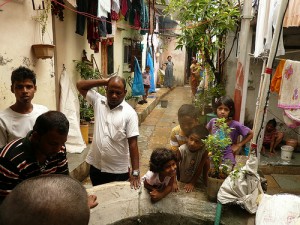 The activists of URBZ collective (of which we wrote in a previous post) are promoting a crowdfunding campaign to develop a plot of land in the neighbourhood of Bhandup in the northwestern suburbs of Mumbai. Their intention is to build there an affordable house, compatible with local construction styles: “homegrown“, and produced in collaboration with local constructors. The house will be sold at reasonable conditions to residents, thus providing the funds for a new project. The idea is to contribute to develop better life conditions for the residents of the so-called “slums”, without depending on international aid or having to rely on NGOs. This homegrown development works against the logic of the big eviction and relocation projects promoted by the state: as happened too often, these top-down projects end up eradicating the population and forcing them into vertical housing blocks, which represent the degree zero of architectural, urban and social thinking, and have been responsible for countless man-made urban disasters in poor and rich countries alike.
The activists of URBZ collective (of which we wrote in a previous post) are promoting a crowdfunding campaign to develop a plot of land in the neighbourhood of Bhandup in the northwestern suburbs of Mumbai. Their intention is to build there an affordable house, compatible with local construction styles: “homegrown“, and produced in collaboration with local constructors. The house will be sold at reasonable conditions to residents, thus providing the funds for a new project. The idea is to contribute to develop better life conditions for the residents of the so-called “slums”, without depending on international aid or having to rely on NGOs. This homegrown development works against the logic of the big eviction and relocation projects promoted by the state: as happened too often, these top-down projects end up eradicating the population and forcing them into vertical housing blocks, which represent the degree zero of architectural, urban and social thinking, and have been responsible for countless man-made urban disasters in poor and rich countries alike.
- Homegrown cities project en Urbz.net
- Join Homegrown cities crowdfunding on indiegogo
- Airoots/Eirut, Matias Echanove and Raoul Srivastava‘s blog
- Interview with Amar Mirjankar, a local contractor the activists are working with [video].
- Documentación sobre la forma local de construir viviendas baratas: video, y artículo “The 2,5 lakh rupee house” en Urbz.net